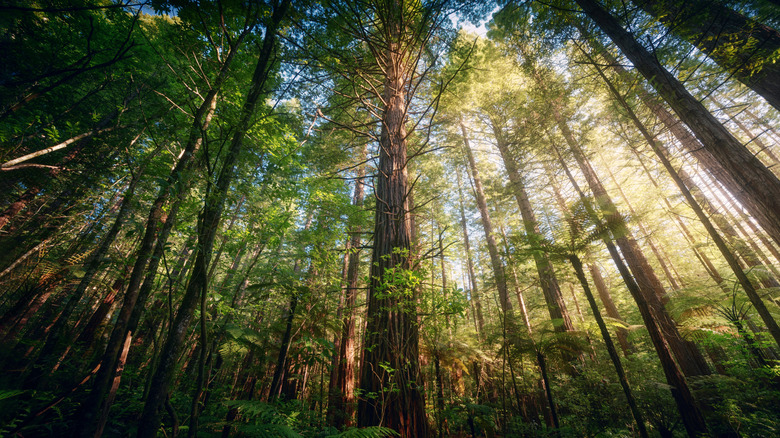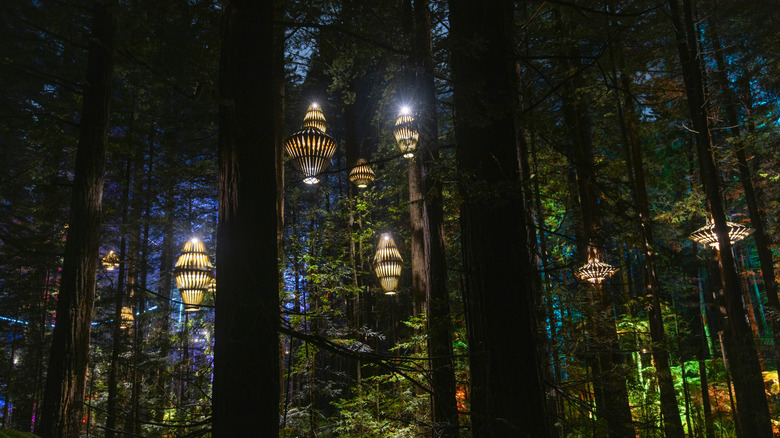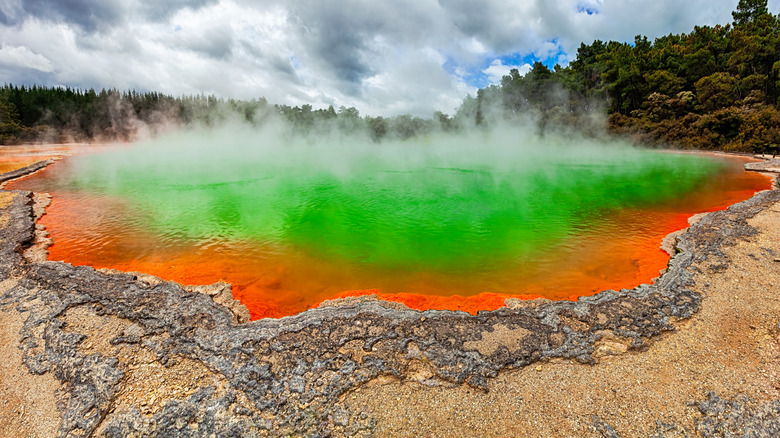A Magical New Zealand Park With Spellbinding Trails Is One Of Few Redwood Forests Outside Of America
It's unusual to hear of a California coast redwood outside of California, and the majority of the population of the world's tallest trees grow in otherworldly Redwoods National and State Parks. But New Zealand's North Island has its own small thriving population, successfully introduced and integrated into the local ecosystem in the early 20th century. Trees originally intended to be cut down for timber were deemed too beautiful to chop down. Instead, they've been left to grow for the last 125 years (relatively young for a redwood!), standing as a protected grove within Rotorua's Whakarewarewa Forest named, aptly enough, The Redwoods.
New Zealand's brought The Redwoods to life in a mystical way only the country that's doubled as Middle Earth would think up, strung with suspension bridge trails and glowing elvish wooden lanterns. Across the park's 14,000 acres, this 14-acre stretch of forest has become the most trafficked. But redwoods aren't the only unusual growth in Whakarewarewa.
The forest is home to other imported species, all well-acclimated to Rotorua's misty, volcanic atmosphere near the sea. Species like Monterey pine, European larch, Japanese cedar, Mexican cypress, and more grow interspersed with native silver fern, offering shelter to native avians like fantails and bellbirds and creating a lush paradise full of footpaths and world-class mountain biking trails. Best of all, The Redwoods are a mere 10-minute drive from Rotorua's town center, making them easy to access no matter the hour.
The Treewalk and other ways to explore Whakarewarewa Forest
The iconic Wanaka Tree might be Instagram-famous for its year-round breathtaking views, but Whakarewarewa's 240-foot-tall redwoods have become a crowd favorite, so rare a sight they are. To enhance their spectacle, the park has strung 28 eco-friendly suspension bridges up to 65-feet-high among its 14 acres of redwood forest — a walk through the trees, full of information panels about the ecosystem and how they came to be planted here. There are also glass viewing panels through which you can see the forest floor directly below your feet and 30 fairytale-like lanterns designed by New Zealand eco-artist David Trubridge to illuminate the way at night.
The family-friendly Treewalk is just under half a mile in total, and takes around 40 minutes to complete. Passes for day or night entry are NZ$42 (US$25) per adult and NZ$26 (US$16) per child as of this publication. Intrepid visitors can opt for the Redwoods Altitude experience, which incorporates narrower suspension bridges, zip lines, and spiral staircases in a course closer to the canopy for NZ$125 (US$75).
There are trails on the forest floor as well. The Redwood Memorial Grove Track follows a 1.2-mile mobility-accessible boardwalk through the grove to a thermal pool, while the more challenging 3-mile Quarry Lookout Track hikes above the trees, to a lookout across town and Lake Rotorua. Whakarewarewa Forest's mountain biking courses have also received high marks, with 100 miles of trails fit for beginners to experts. You can hire a guide if you need and, as the adventure capital of New Zealand's North Island, Rotorua has bike and equipment rentals in town. Wildlife is scarce during the day, making trails safe to navigate, though a number of birds — including tuis, kererus, and wax eyes — and dragonflies paint the foliated skies.
Discovering Rotorua's other natural treasures
If you're wondering how to spend your time in New Zealand, know that Rotorua is worth more than just a day. It's a three-hour drive from Auckland and just 40 miles south of the popular beach town Tauranga and the Bay of Plenty, making it easy to weave into a longer itinerary. You could either fly into Rotorua Airport (ROT) or drive — making a pit-stop in Matamata to see the Hobbiton movie set. But Air New Zealand's 20 travel hubs throughout the tiny island nation make it easy to get around if you're tight on time.
More so than its forests, Rotorua is perhaps best known for its preservation of Māori culture and geothermal landscapes. In fact, its nickname is "Sulphur City." South of town, in the Whakarewarewa Thermal Reserve, "Te Puia" (the park's nickname) is home to geysers, mud baths, and steam vents, plus a cultural center where you can learn about the Māori tribes and their arts — these people are well known for their polished wood carving. You can learn about the importance of jade carving on a tour through one of the artisan workshops in town. Or you can travel 30 minutes south to the arguably more impressive Wai-O-Tapu Thermal Wonderland.
Rotorua hosts a second Māori cultural village, Mitai, where you can enjoy a traditional meal and the reconstruction of an ancient village. There are watersports like stand-up paddle boarding and kayaking on placid Lake Rotorua or thrilling waterfall rafting on Kaituna River. Or for those who'd like to relax, you can enjoy the restorative effects of the town's natural hot springs at places like the Lake Rotoiti Hot Pools and the Polynesian Spa.


